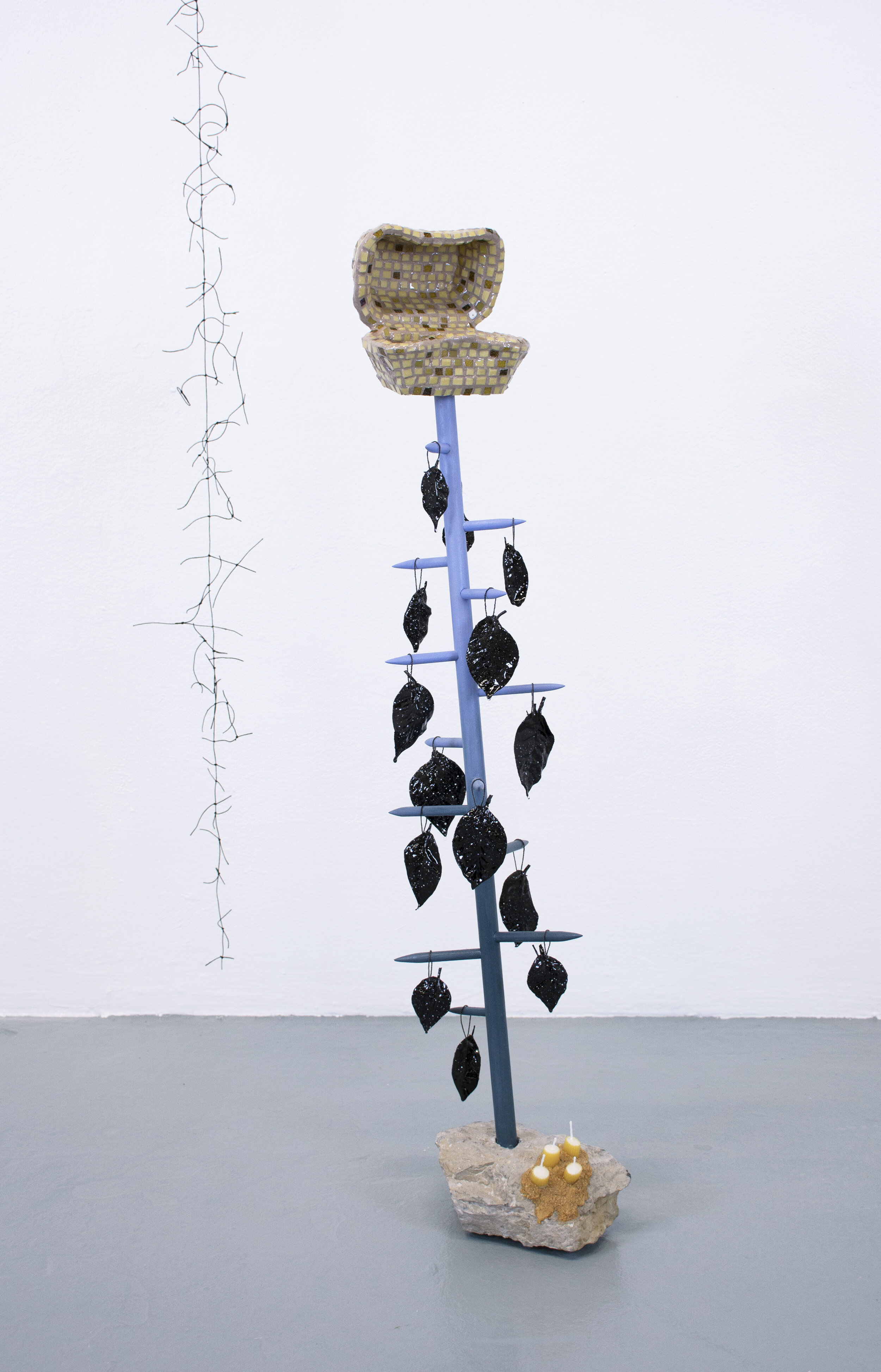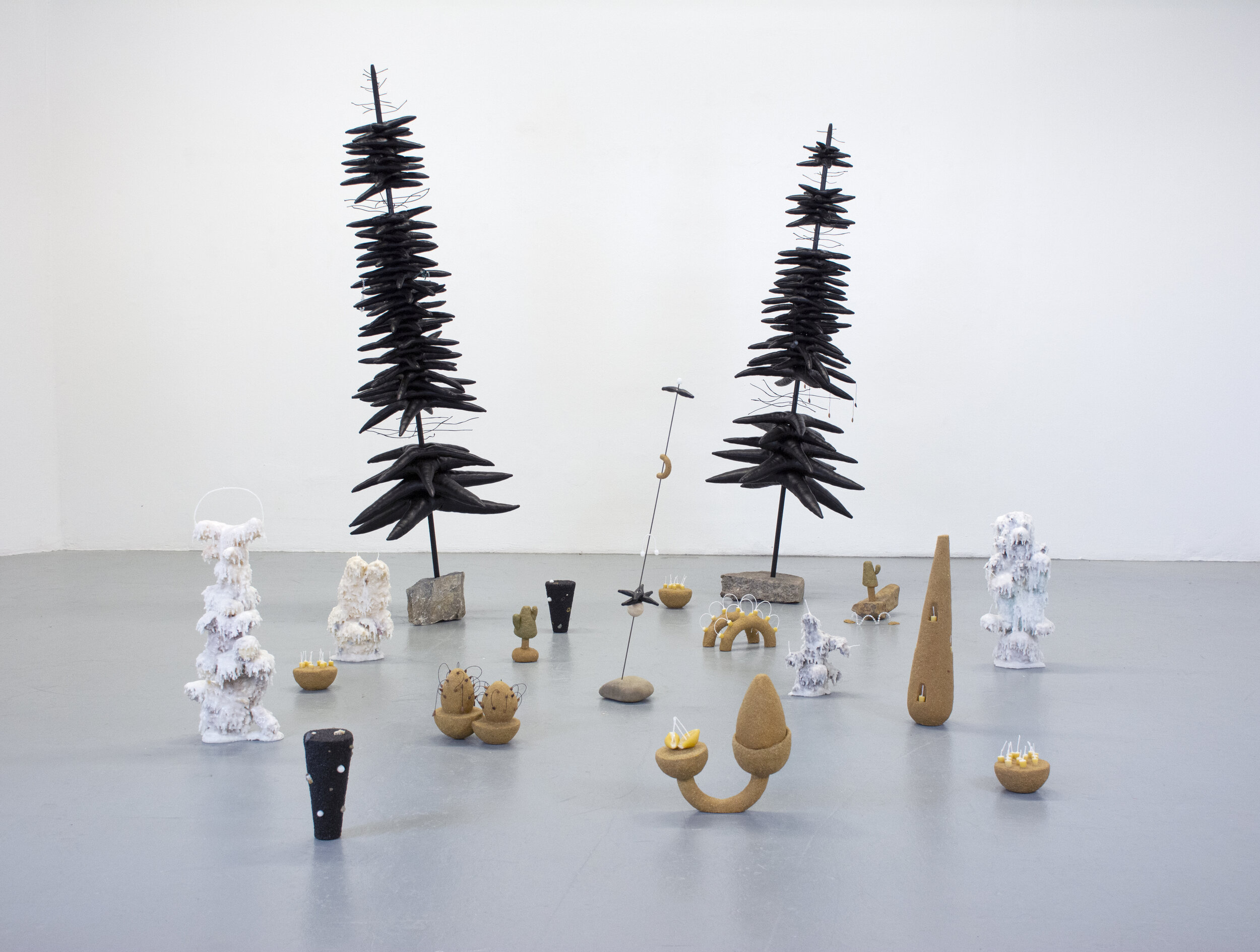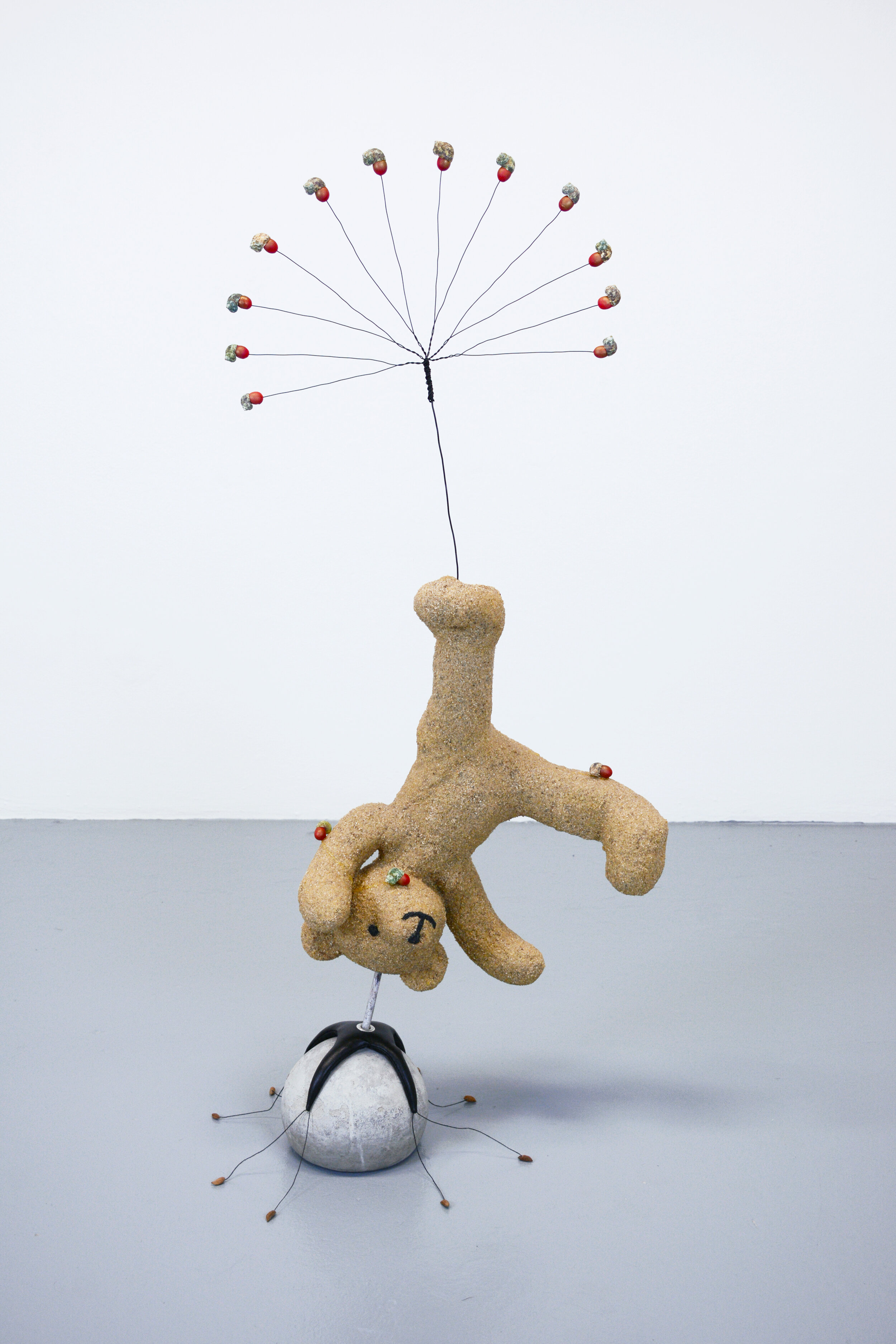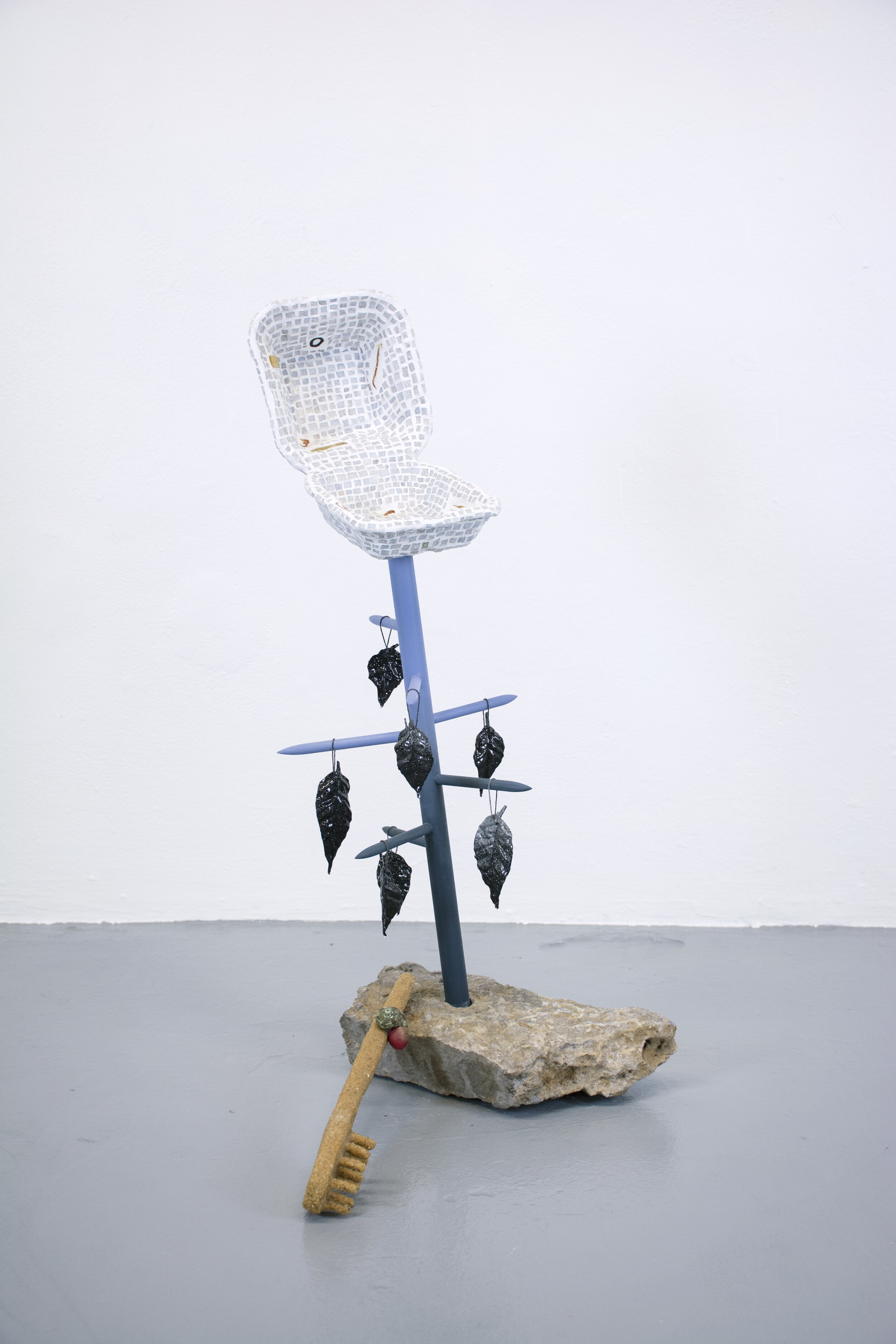Interview with Sidney Mullis
Sidney Mullis
Altar, 2017-2019
Handmade paper pulp, gravestone dust collected from a gravestone carver, wax, sand, dry rigatoni and manicotti pasta, pleather, black streamers, teddies that people did not want, olive pits, paint, wire, shells & coins from my childhood collections
8 x 4 x 8 ft.
Sidney Mullis is a sculptor who makes work about puberty, the intimacy of forgetting, the performance of gender, and the resurrection of childhood selves. From her training as a dancer, she is sensitive to how bodies move through space, and the narrow bandwidth in which they can do so safely and without scrutiny. Now, her dance partners are her materials. It is through making that she tries to understand normative values and how systems of authority develop into ‘the way things are’— and, more importantly, to see what they could be.
In this interview, Sidney speaks with Thomas Flynn II of FOA to discuss one of her latest bodies of work referencing the mutability of time, coming-of-age-rituals and her attempts to resurrect her 7-year-old-self, Sid-the-Kid.
Thomas: You have several large and varied bodies of work. I would love to focus this interview on a recent series, “when small words made big worlds.” There are so many different components in the work that all come together to create this minefield of a scene. Can you walk us through some highlights?
Sidney: I am building a ceremonial landscape that is the resurrection space for my seven-year-old self, who I've been calling Sid-the-Kid. In this world is an altar—the central resurrecting device—made of handmade paper pulp and gravestone dust. It is decked with dry rigatoni and manicotti pasta candles, limp pom-pom streamers, and teddies preserved upside own in wax.
Surrounding the altar are types of growth that appear related to trees. This growth sprouts from inside rocks and ends in styrofoam containers preserved in mosaic tile. Foodstuffs, like peas, olives, carrots, and red onion, have been dried and imbedded into the mosaic connoting the last meal the containers held.
Between the trees are larger slices of this world, sculptural installations. Built of many parts, they appear mutable, as if staged for performance, play, or ritual. The objects lean and teeter as if learning to hold their weight or after an acute seismic shift. Perhaps appearing toy-like at first, the pieces are overtaken by wax and wicks marking the scene with inevitable demise, or the taunt of it.
Thomas: One thing that comes to mind when thinking about your work is the concept of “coming-of-age.” Would you mind talking about your thoughts on this?
Sidney: Yes, this work is very much about coming-of-age. Admittedly, I have so many thoughts about it that I am still trying to sort though. It is that (messy and imperfect) sorting that helps generate the work.
This started when I was told I should feel grown up now. I immediately felt this intense opposition to joining this American society that, through the very act of joining it, quietly validates its systems as the best possible option for the next years of my life. Quiet, social integration? Right now? No, thank you.
Through research, I found that "Bildungsroman" is considered to be the word to have generated this notion of coming-of-age. It’s a German word coined in 1819 by Karl Morgenstern. Stemming from literature, it is described as the hero’s development toward a certain level of perfection. In these stories, the reader follows the journey of the protagonist toward self integration, and thus, social integration.
Resurrecting Sid-the-Kid in this body of work is an act of resistance to the formation of a self that validates American society as it is, and stalls the formation of a self in opposition to coming-of-age tropes. Tropes that are from a man's perspective, born out of a man’s story, to prepare children for a man's world.
Thomas: There are some reoccurring materials at play in this work. Can you speak about what keeps you coming back to materials like sand, pasta, wax, candles, and teddybears?
Sidney: Yea! I am interested in using most of these materials to reference childhood, but I often push them past a knowable position in hopes that people will have that moment of getting to know them again, in a different way.
The sand has a reference to sandcastles and sand boxes. The dry pasta: elementary school art projects. I have been using dry rigatoni and manicotti as a container for wax and wick. They have become the votive candle for this spiritual environment.
The teddybears are, perhaps, the most known symbol for childhood. My teddy, Bearly, was the first object (or soft sculpture, if you will) I knew I loved as a child. By placing the teddies upside down on their heads, solidified in wax, I am able to elicit this strange sympathy from viewers. Despite our older age, we still care for them in a way. The wax casing becomes this attempt at preservation, but the wicks show that they won’t last if lit. It’s a weird attempt to both keep and let go. They showed me that I am trying to keep and let go.
Thomas: Much of your work focuses on the idea of time, especially our perception and experience of it. In the past this has been used to explore the ideas of puberty and memories. How has the concept of time expanded in your newest work?
Sidney: Time, yes! In order to go back in time in this body of work, as well as race forward and stand still, I wanted to see how time could take physical shape.
I started boring into rocks as a way to get close to understanding deep time. By scooping material out of a rock, I could see those compressed layers of lifetimes. This became transformative for me, especially when I started to rely on them as bases—to physically hold up the work. Using millennia for a moment. Feels very human.
I also starting thinking about the candle wick as a sculptural unit. If I loop a wick around and through a piece or use a wick as a tether, I am then asked to consider how it would burn, in what direction, and for how long? This reorients my understanding of measured and linear time and gives agency to a more topsy-turvy, collapsible and convoluted sense of time. It forces the questions, “How do I know time? How does it mark my understanding of my experiences? How does it make me age?”
I think it’s safe to say there will be more wicks in the long, looping future.
Thomas: Your creative process seems to be intuitive, can you talk a bit about your thoughts and inspiration when making new leaps such as your handmade paper pulp, or using large rocks as bases?
Sidney: I approach art making very playfully—jumping from process to process never seeking mastery, but play, joy, and pleasure. It is as wonderful as it is terrifying. Similar to being a kid, really.
And, by always taking on the role of amateur or novice, rules of mastery do not really apply to my practice. The rules are then limitless, fluid, every-changing, and imperfect. This is so much more exciting for me than working toward dominant standards or hierarchies that have been given to me.
Thomas: I’d like to end our interview by asking you to share your best piece of advice you have received or would like to give to the artists reading the publication.
Sidney: The best piece of advice I received was in June 2016 and in the form of a question. I have been toting it around with me since and using it as a tool to measure how I am making decisions about my career + life.
Freshly out of graduate school, I was talking with the amazing artist and person George Ferrandi. I was sharing all of these things I was interviewing and applying for, desperately trying to find my next steps. She asked:
“What does success look like for you?”
This took me aback and made me realize that I was just thrusting myself into potential jobs and scenarios, mainly to alleviate external pressure sourced from others.
This question considers my worth. This question dissolves surrounding distractions. It gives me space to craft notions of ‘success’ on my terms, and to let them evolve when I want them to. It allows me to take what I have been told has value and develop this for myself and within my own systems. Since then, I have been asking myself this question in order to clearly define my priorities first and then find the solutions that support them.






